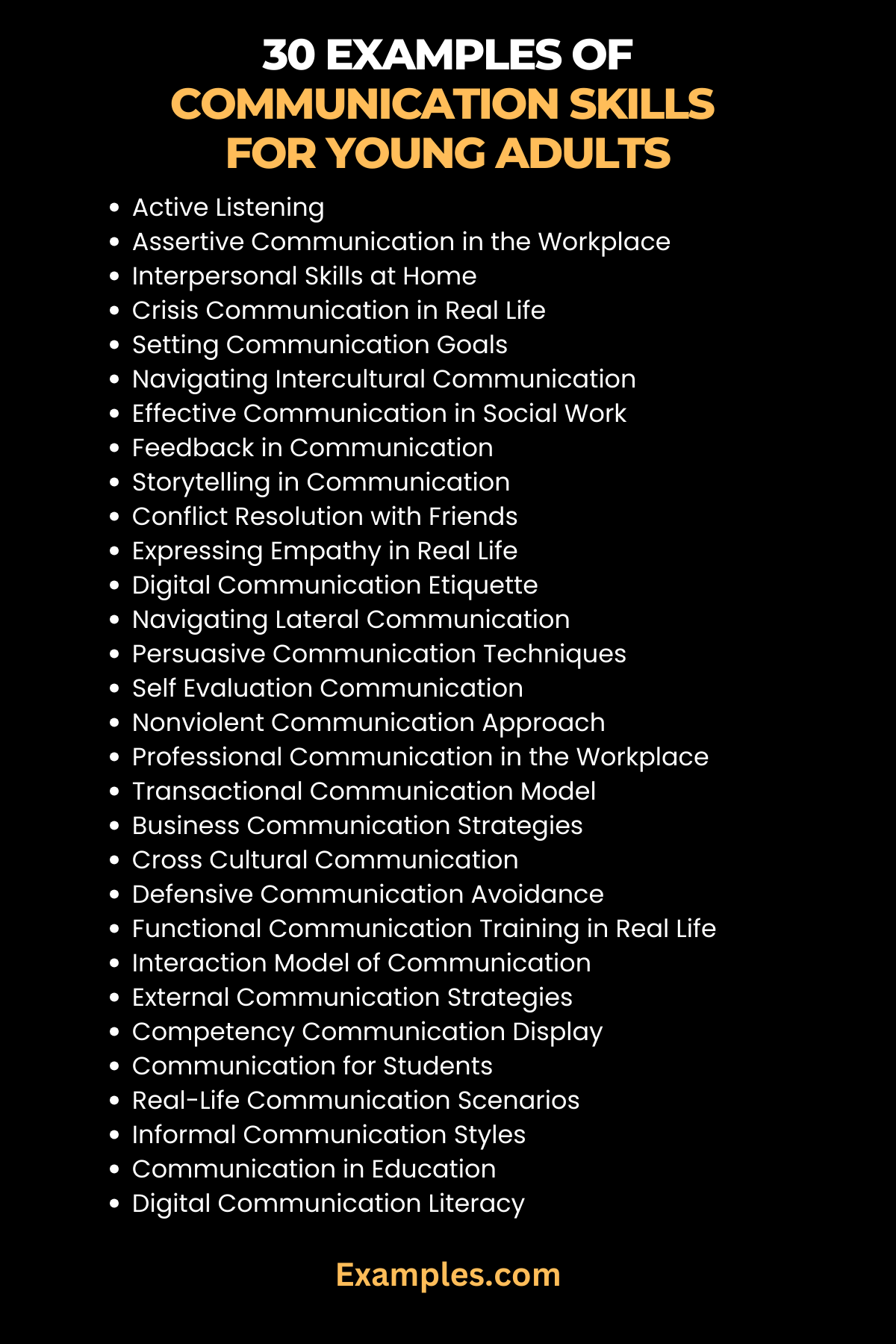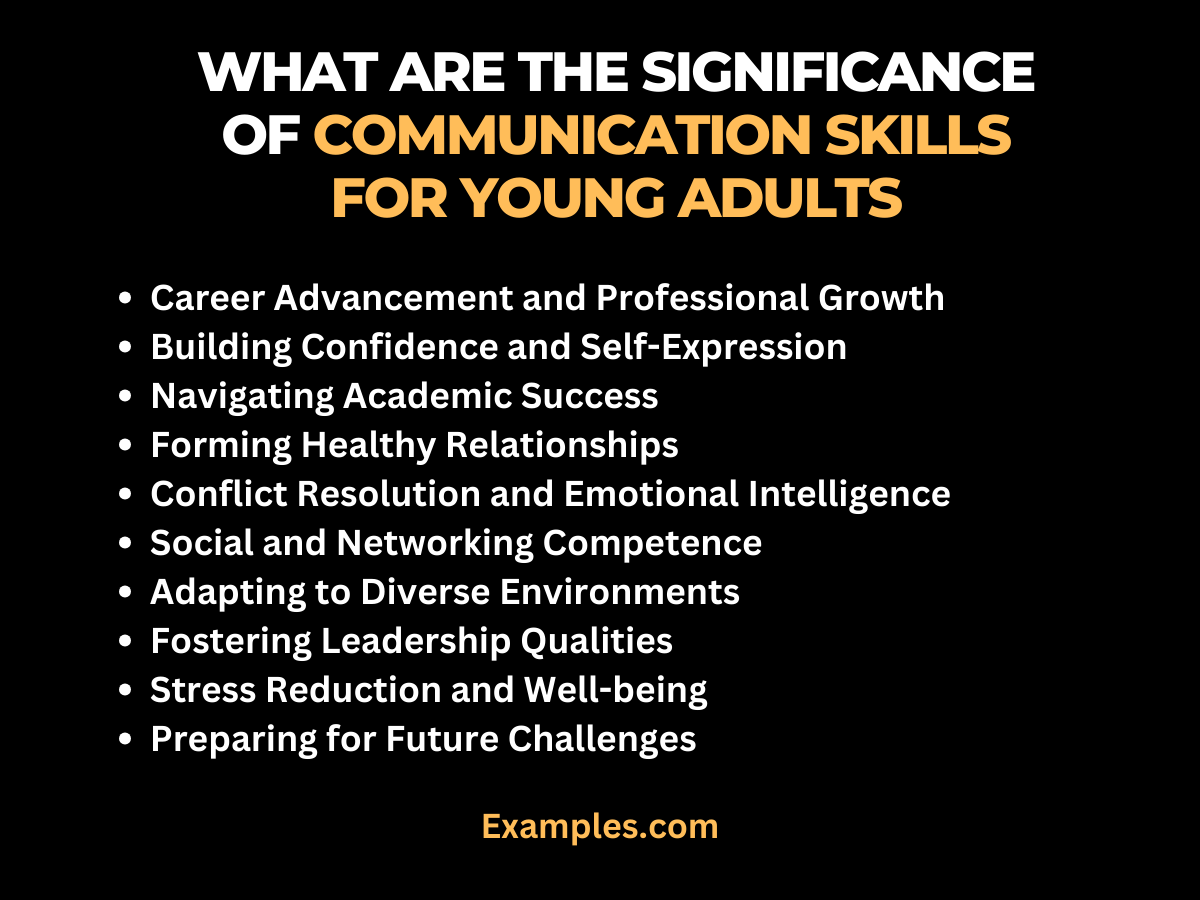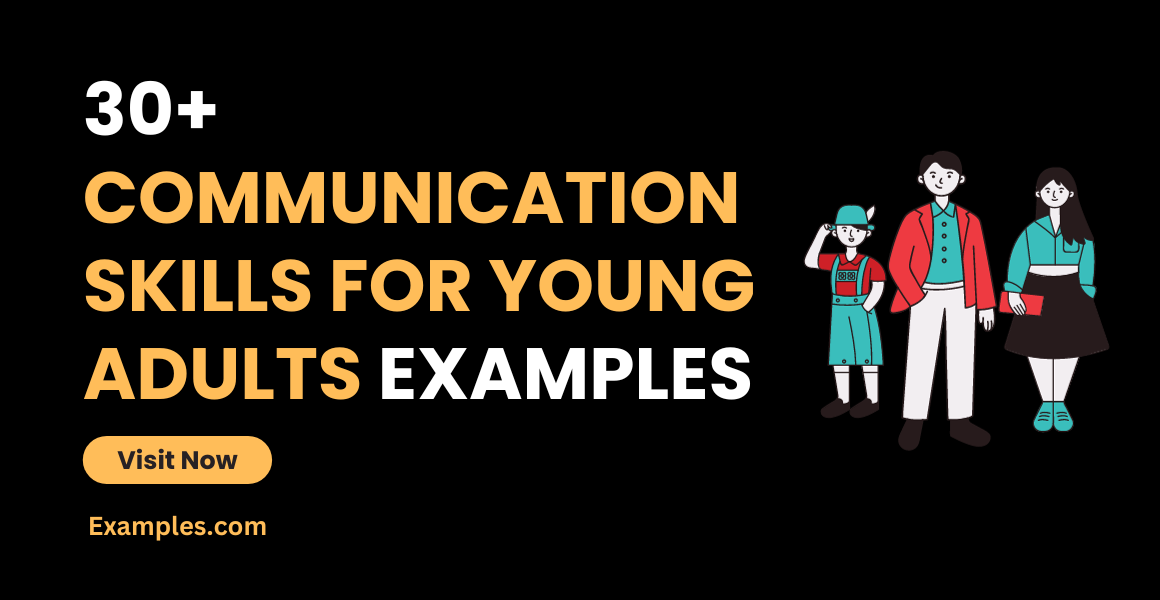29+ Communication Skills for Young Adults Examples
Embark on a transformative journey into the realm of effective communication for young adults. This comprehensive guide is a beacon for honing Communication Examples that empower young individuals in real-life scenarios. From navigating the workplace to fostering connections at home, discover the skills, strategies, and practical insights that will propel young adults toward success in their personal and professional lives.
30 Examples of Communication Skills For Young Adults
Empower the youth with our guide featuring 30 Communication Skills for Young Adults Examples. This resource provides actionable insights and expert tips for navigating the complexities of real-life scenarios. From workplace interactions to family dynamics, these examples serve as a compass for mastering the art of effective communication, fostering resilience and success in every facet of young adults’ lives.

- Active Listening:
- Show respect and understanding by using the bold phrase, “I hear your perspective; let’s discuss it further.”
- Assertive Communication in the Workplace:
- Navigate professional challenges confidently with the bold statement, “I appreciate your input; here’s my perspective on the matter.”
- Interpersonal Skills at Home:
- Strengthen family bonds with the bold communication, “Let’s collaboratively decide on our weekend plans to accommodate everyone’s preferences.”
- Crisis Communication in Real Life:
- Handle emergencies effectively by saying, “Stay calm; we’ll work together to find a solution and ensure everyone’s safety.”
- Setting Communication Goals:
- Promote personal growth by using the bold statement, “Let’s set communication goals to enhance our relationships and interactions.”
- Navigating Intercultural Communication:
- Acknowledge diversity with the bold phrase, “In our multicultural world, let’s embrace and learn from each other’s backgrounds.”
- Effective Communication in Social Work:
- Support clients by using the bold statement, “Your concerns matter; let’s collaborate on a plan to address them together.”
- Feedback in Communication:
- Encourage growth with the bold communication, “Your contributions are valuable; here’s constructive feedback to help you excel further.”
- Storytelling in Communication:
- Capture attention with engaging stories, illustrating complex ideas and making communication more relatable.
- Conflict Resolution with Friends:
- Resolve conflicts with the bold statement, “Let’s openly discuss our differences and find common ground to strengthen our friendship.”
- Expressing Empathy in Real Life:
- Show compassion with the bold phrase, “I understand what you’re going through; how can I support you during this time?”
- Digital Communication Etiquette:
- Navigate online interactions effectively by stating, “Let’s use digital platforms responsibly, ensuring clear and respectful communication.”
- Navigating Lateral Communication:
- Build effective relationships with colleagues by using the bold statement, “Let’s communicate laterally to enhance teamwork and collaboration.”
- Persuasive Communication Techniques:
- Influence positively with the bold communication, “Presenting compelling arguments, let’s explore ideas that benefit everyone involved.”
- Self Evaluation Communication:
- Reflect on personal growth with the bold statement, “Regular self-evaluation helps us refine our communication skills for continuous improvement.”
- Nonviolent Communication Approach:
- Resolve conflicts peacefully by using the bold phrase, “Let’s communicate without aggression, focusing on mutual understanding and resolution.”
- Professional Communication in the Workplace:
- Navigate the corporate landscape with the bold communication, “Maintaining professionalism, let’s communicate effectively to achieve our work goals.”
- Transactional Communication Model:
- Understand complex interactions by using the bold statement, “In our transactions, let’s consider the full communication process for clarity and efficiency.”
- Business Communication Strategies:
- Achieve success with the bold phrase, “In business, effective communication is key; let’s strategize to convey our ideas convincingly.”
- Cross Cultural Communication:
- Bridge cultural gaps with the bold communication, “Understanding diverse cultures, let’s communicate respectfully and promote inclusivity.”
- Defensive Communication Avoidance:
- Foster open dialogue with the bold statement, “Avoiding defensiveness, let’s communicate transparently and address concerns proactively.”
- Functional Communication Training in Real Life:
- Enhance daily interactions with the bold communication, “Applying functional communication skills, let’s navigate challenges more efficiently.”
- Interaction Model of Communication:
- Understand communication dynamics with the bold statement, “Exploring the interaction model, let’s refine our approach for more effective conversations.”
- External Communication Strategies:
- Engage external audiences with the bold phrase, “In external communications, let’s tailor our message for maximum impact and resonance.”
- Competency Communication Display:
- Showcase skills effectively with the bold communication, “Highlighting our competencies, let’s communicate our strengths confidently.”
- Communication for Students:
- Support academic success with the bold statement, “As students, effective communication enhances our learning and collaboration.”
- Real-Life Communication Scenarios:
- Navigate diverse situations with the bold communication, “In real-life scenarios, let’s adapt our communication for optimal outcomes.”
- Informal Communication Styles:
- Build rapport with the bold phrase, “In informal settings, let’s embrace diverse communication styles for authentic connections.”
- Communication in Education:
- Facilitate learning with the bold communication, “In education, effective communication is the key to fostering a positive and engaging environment.”
- Digital Communication Literacy:
- Navigate the digital landscape with the bold statement, “In the digital age, let’s enhance our literacy for clear and impactful online communication.”
Communication Skills for Young Adults in Real Life
Embark on a journey of authentic communication with our guide on Communication Skills for Young Adults in Real Life. Delve into practical examples and insights that empower young individuals to navigate personal and social scenarios with confidence and clarity.
- Conversations with Family Members:
- Enhance family bonds with the bold communication, “I value our time together; let’s plan a weekend activity that everyone can enjoy.”
- Resolving Friendship Conflicts:
- Maintain healthy friendships with the bold statement, “I noticed a change in our dynamics; can we talk and address any concerns?”
- Effective Dating Communication:
- Navigate dating scenarios confidently with the bold phrase, “I appreciate your honesty; let’s communicate openly to ensure we’re on the same page.”
- Handling Peer Pressure Dialogue:
- Boldly resist peer pressure with the phrase, “I’m comfortable with my choices; let’s respect each other’s decisions.”
- Expressing Support to Friends:
- Show empathy with the bold statement, “I understand this is challenging for you; I’m here to support and listen whenever you need.”
- Navigating Social Events:
- Enhance social interactions with the bold communication, “I enjoy our conversations; let’s plan more gatherings to catch up and share experiences.”
- Discussing Personal Boundaries:
- Boldly establish boundaries with the phrase, “Respecting personal space is important; let’s communicate openly about our expectations.”
- Handling Disagreements with Roommates:
- Resolve conflicts peacefully with the bold statement, “I noticed some tension; let’s discuss and find compromises for a harmonious living situation.”
- Effective Communication with Neighbours:
- Build a supportive community with the bold communication, “I appreciate our neighbourly relationship; let’s communicate openly about any concerns or shared responsibilities.”
- Supporting Friends Through Challenges:
- Show compassion with the bold phrase, “I heard about your struggles; let’s talk and explore how I can be a supportive friend during this time.
Communication Skills for Young Adults at Workplace
Navigate the professional landscape with finesse using our guide on Communication Skills for Young Adults at the Workplace. Tailored for career success, this resource empowers young professionals with practical examples and strategies to excel in communication within corporate settings.
- Leading Effective Team Meetings:
- Foster collaboration with the bold communication, “I’ve outlined the agenda; let’s ensure a productive discussion during our team meeting.”
- Articulating Ideas in Brainstorming Sessions:
- Contribute innovatively with the bold phrase, “I have a creative suggestion; let’s explore how it aligns with our project goals.”
- Constructive Feedback Dialogue:
- Facilitate growth with the bold statement, “I appreciate your efforts; here’s constructive feedback to help you excel further.”
- Project Status Updates:
- Keep the team informed with the bold communication, “I’ve completed my part; let’s discuss the overall progress in our next project update.”
- Professional Email Etiquette:
- Navigate email communication effectively with the bold phrase, “In the attached document, you’ll find the detailed report; let’s discuss any insights during our meeting.”
- Handling Workplace Criticism:
- Respond professionally with the bold communication, “I value constructive feedback; let’s discuss specific areas for improvement and growth.”
- Negotiating Professional Development Opportunities:
- Boldly express career aspirations with the statement, “I’m eager to pursue professional development; let’s explore opportunities that align with my goals.”
- Communicating Achievements to Superiors:
- Showcase accomplishments with the bold communication, “I achieved the project goals; let’s discuss the impact on our team and department.”
- Navigating Workplace Changes Dialogue:
- Manage transitions with the bold phrase, “I’ve noticed recent changes; let’s discuss how they may impact our workflow and collaboration.”
- Effective Communication in Cross-Functional Teams:
- Promote synergy with the bold statement, “I appreciate our diverse talents; let’s communicate effectively to leverage our strengths in cross-functional projects.”
Communication Skills for Young Adults at Home
Elevate your family dynamics with Communication Skills for Young Adults at home. This guide explores the nuanced art of effective communication within the family setting, offering insights, strategies, and practical examples to strengthen bonds and foster a harmonious home environment.
- Navigating Family Decisions:
- Boldly communicate, “Let’s collaboratively decide on family plans, ensuring everyone’s input is valued and considered.”
- Expressing Gratitude to Parents:
- Show appreciation with the bold phrase, “Thank you for your support; your efforts are truly valued in our home.”
- Balancing Chores and Responsibilities:
- Delegate tasks with the bold statement, “Let’s discuss and distribute household responsibilities for a more balanced home life.”
- Discussing Personal Boundaries:
- Set boundaries with the bold communication, “Respectful communication ensures we understand and honour each other’s personal space.”
- Quality Time Planning with Siblings:
- Strengthen sibling bonds with the bold phrase, “Let’s plan quality time together to nurture our relationships as a family.”
- Resolving Conflicts Peacefully:
- Address disputes with the bold communication, “Let’s engage in calm dialogue to find resolutions and maintain harmony at home.”
- Sharing Personal Achievements:
- Celebrate successes with the bold statement, “Openly sharing our achievements creates a positive and supportive atmosphere in our home.”
- Family Vision Board Creation:
- Foster shared aspirations with the bold phrase, “Let’s create a family vision board, outlining our collective goals and dreams.”
- Discussing Future Plans:
- Plan for the future with the bold communication, “Open dialogue about our individual and family aspirations ensures alignment and support.”
- Establishing Digital Usage Guidelines:
- Set digital boundaries with the bold statement, “Let’s establish guidelines for responsible digital use to maintain a healthy home environment.”
What Are The Communication Strategies for Young Adults
Mastering communication is pivotal for young adults navigating the complexities of adulthood. This comprehensive guide explores dynamic strategies tailored to the unique needs of this demographic. From active listening to assertive expression, discover practical communication skills that empower young adults in personal and professional spheres.

- Active Listening and Empathy:
- Encourage young adults to listen actively, demonstrating genuine empathy for others’ perspectives.
- Navigating Digital Communication:
- Explore the nuances of digital communication, emphasizing clarity and responsibility in online interactions.
- Assertive Communication in the Workplace:
- Equip young adults with the skills to express their thoughts and ideas assertively in professional settings.
- Interpersonal Skills in Social Settings:
- Highlight the importance of developing interpersonal skills for navigating social situations with confidence.
- Conflict Resolution Techniques:
- Empower young adults to address conflicts constructively, fostering resolution and maintaining relationships.
- Effective Written Communication:
- Stress the significance of clear and concise written communication in academic and professional contexts.
- Building and Maintaining Relationships:
- Guide young adults in cultivating and nurturing meaningful relationships through open communication.
- Adapting Communication Styles:
- Encourage flexibility in communication styles to navigate diverse scenarios and connect with a variety of individuals.
- Setting and Achieving Communication Goals:
- Demonstrate the value of setting communication goals to enhance personal and professional growth.
- Navigating Intercultural Communication:
- Explore the importance of cultural sensitivity in communication, promoting inclusivity and understanding.
What Are The Significance of Communication Skills for Young Adults
Effective communication skills are the cornerstone of success for young adults as they transition into adulthood. This guide delves into the profound impact of honing communication skills and how it contributes to personal development, career advancement, and thriving relationships.

- career Advancement and Professional Growth:
- Highlight how strong communication skills enhance employability and contribute to success in the professional arena.
- Building Confidence and Self-Expression:
- Explore how effective communication empowers young adults to express themselves confidently and assertively.
- Navigating Academic Success:
- Illustrate how clear communication aids academic achievement, from effective presentations to articulate writing.
- Forming Healthy Relationships:
- Emphasize the role of communication in cultivating and maintaining positive relationships with peers, mentors, and family.
- Conflict Resolution and Emotional Intelligence:
- Discuss how communication skills contribute to resolving conflicts and developing emotional intelligence.
- Social and Networking Competence:
- Examine how effective communication enhances social interactions and networking capabilities.
- Adapting to Diverse Environments:
- Explore how communication skills facilitate adaptation to diverse cultural and professional environments.
- Fostering Leadership Qualities:
- Showcase how strong communicators often emerge as leaders, influencing and inspiring those around them.
- Stress Reduction and Well-being:
- Highlight the link between effective communication, stress reduction, and overall mental and emotional well-being.
- Preparing for Future Challenges:
- Illustrate how honing communication skills equips young adults to face the challenges of an evolving and dynamic world.
Mastering Communication Skills is the linchpin for young adults navigating the intricate tapestry of life. This comprehensive guide, enriched with diverse examples, equips them with the tools to communicate confidently, fostering success in relationships, academia, and the professional realm. Empowered with this knowledge, young adults embark on a journey of self-expression, collaboration, and resilience, shaping a future of fulfilment and achievement.



